

Zinc - Journal. Chromebooks in Education - A Chromebook review. The Rise of the Chromebook. According to recent figures from the US, in 2014 the Chromebook quickly became the bestselling device in Northern American educational markets and is continuing to grow in popularity.

But are Chromebooks really a panacea for the ever growing and ever evolving educational market? Or are they merely a fad destined to burn out in the years to come? (Netbooks, we are looking at you). And what should schools consider before dipping their toes into the Chromebook realm? A Chromebook is a laptop of a different breed, one that runs Google’s web-based Chrome operating system.
The first Chromebooks to go on sale were manufactured exclusively by Acer and Samsung. To date, customers from the education market have formed the most common type of user for Chromebooks. Popularity for the device is picking up pace around the globe. Chromebooks merge perfectly with Google Apps for Education, which is now used by more than 40 million students and teachers around the world.
EdTechTeacher The beginner’s guide to Chromebooks in the classroom - from Jennifer Carey. This post first appeared on Daily Genius.
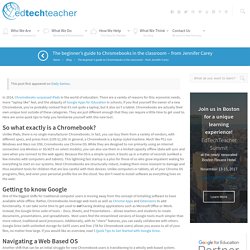
In 2014, Chromebooks surpassed iPads in the world of education. There are a variety of reasons for this: economic needs, more “laptop like” feel, and the ubiquity of Google Apps for Education in schools. If you find yourself the owner of a new Chromebook, you’ve probably noticed that it’s not quite a laptop, but it also isn’t a tablet. Chromebooks are actually their own unique tool outside of these categories. They are just different enough that they can require a little time to get used to. Unlike iPads, there is no single manufacturer Chromebooks.
One of the biggest shifts for traditional computer users is moving away from the concept of installing software to have available while offline. Another shift that can be an initial struggle for new Chromebook users is transitioning to a wholly web-based system. You don’t have icons, a finder menu, or a start menu on Chromebook.
View the Full Course Catalog at ettsummer.org. Chromebooks. Technology in the Classroom: Amazing iPad Apps for Educators. When one looks at how technology has changed education over the past decade, one can’t help but be blown away by the sheer number of iPad apps for educators that have absolutely flooded the electronic marketplace.

There are so many iPad apps for teachers released every month that even the most plugged-in educator would have a difficult time processing and utilizing them all. Luckily, when teachers are looking to learn how to use iPads in the classroom, they need to look no further than TeachHUB magazine and TeachHUB.com -- an educator’s primary go-to resource when researching iPad apps for teachers and iPads in the classroom. Read on to learn about TeachHUB magazine and TeachHUB.com’s updated list of the hottest iPad apps for teachers and iPad apps for education, destined to forever alter your curriculum landscape, organized here by subject.
Scroll down for an index of many of TeachHUB's helpful iPads in the classroom app reviews and more of the best usage of iPads in the classroom. iPads in the Classroom. Edutopia. Updated 01/2014 If I had thirty iPads in my class, what would I do with them? How would I use them to help my students learn better and help me teach better? 31 Reasons You Should Be Using iPads in the Classroom. Here on the SecurEdge blog, we think a lot about mobile technology, especially iPads and how challenging they have become for school wireless networks to support.
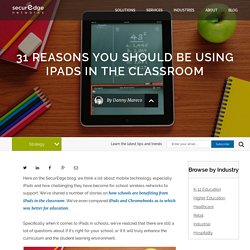
We’ve shared a number of stories on how schools are benefiting from iPads in the classroom. We’ve even compared iPads and Chromebooks as to which was better for education. Specifically when it comes to iPads in schools, we’ve realized that there are still a lot of questions about if it’s right for your school, or if it will truly enhance the curriculum and the student learning environment.
It’s our belief that every school's wireless network design and strategy is unique to their situation and exact needs. For a lot of schools choosing to implement iPads is a big decision. 8 Examples of Transforming Lessons Through the SAMR Cycle. The SAMR Model for integrating technology into teaching, developed by Dr.
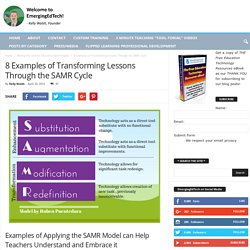
Ruben Puentedura, has gained a good deal of exposure in recent years. “SAMR” is an acronym that stands for Substitution, Augmentation, Modification, and Redefinition. The SAMR model provides a technique for moving through degrees of technology adoption to find more meaningful uses of technology in teaching and move away from simply using “tech for tech’s sake”. SAMR. Bloom’s Taxonomy. Background Information | The Original Taxonomy | The Revised Taxonomy | Why Use Bloom’s Taxonomy? | Further Information The above graphic is released under a Creative Commons Attribution license. You’re free to share, reproduce, or otherwise use it, as long as you attribute it to the Vanderbilt University Center for Teaching. For a higher resolution version, visit our Flickr account and look for the “Download this photo” icon. Background Information. Skills for the 21st Century: teaching higher-order thinking.
This article originally appeared in the April 2014 edition of ISQ Briefings, a publication of Independent Schools Queensland.

Republished with permission. It is hard to imagine a teacher or school leader who is not aware of the importance of teaching higher-order thinking skills to prepare young men and women to live in the 21st Century. However, the extent to which higher-order thinking skills are taught and assessed continues to be an area of debate, with many teachers and employers expressing concern that young people ‘cannot think’. What are we talking about when we talk about ‘higher-order thinking’? Brookhart (2010) identifies definitions of higher-order thinking as falling into three categories: (1) those that define higher-order thinking in terms of transfer, (2) those that define it in terms of critical thinking, and (3) those that define it in terms of problem solving. 10x10 Presents Girl Rising (Official Trailer) Girls' education and gender equality.
Despite progress in recent years, girls continue to suffer severe disadvantage and exclusion in education systems throughout their lives.
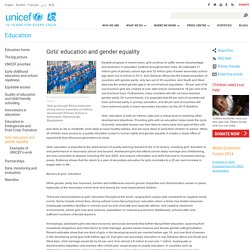
An estimated 31 million girls of primary school age and 32 million girls of lower secondary school age were out of school in 2013. Sub-Saharan Africa has the lowest proportion of countries with gender parity: only two out of 35 countries. Inside Zaatari: Syrian refugees turn desert into one of the world's largest refugee camps. Updated In the dusty desert of northern Jordan a city has emerged out of the sand.
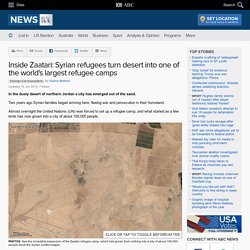
Two years ago Syrian families began arriving here, fleeing war and persecution in their homeland. Almost overnight the United Nations (UN) was forced to set up a refugee camp, and what started as a few tents has now grown into a city of about 100,000 people. The Educational and Mental Health Needs of Syrian Refugee Children. The Syrian civil war, which began in March 2011, has subsequently displaced nearly 12 million people—more than 4 million of them beyond Syria's borders.

Children under the age of 18 represent about half of the Syrian refugee population, with approximately 40 percent under the age of 12. As the refugee crisis continues to unfold, this report takes stock of what is happening to these displaced children. Upon arrival in countries of first asylum, Syrian children have encountered various disruptions and barriers to receiving an adequate education. Approximately half were not enrolled in school in mid-2015; enrollment rates may be as low as 20 percent in Lebanon and 30 percent in Turkey. Even when they do enroll, Syrian children are more likely than their nonrefugee peers to receive poor or failing grades, or to drop out. Syria Crisis – 4 Years On: Education caught in the crossfire of conflict. Education caught in the crossfire of conflict. The attack on Al Hayat Primary School in Qaboun, eastern Damascus in November 2014 killed 11 children and injured many more.
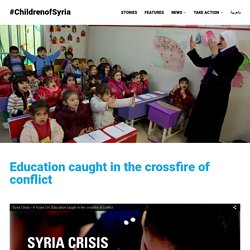
The horrific scenes that were shown on television and on the internet sparked widespread revulsion and condemnation. But the Qaboun assault was just one of at least 68 attacks on schools across Syria between January and December 2014 alone, which caused an undetermined number of casualties among children and staff. All told, since the conflict began, more than 4,200 schools – around 1 in 5 – have been damaged, destroyed, or are currently sheltering internally displaced people according to data gathered by UNICEF. Syria’s once-proud education system, its pupils and teachers, has suffered terrible punishment since the country’s nightmare descent into crisis and conflict began.
International humanitarian law, which declares that schools be respected as zones of peace and safe havens for children, has counted for little. Without education, Syria’s children will be a lost generation. Amid the Syrian chaos of carnage, starvation and evacuation, there is a tiny glimmer of hope. The Lebanese government has declared that it has taken 207,000 Syrian refugee children off the streets and given them places in their country’s public schools. And today I am setting out a plan to extend the opportunity of education to 1 million refugee boys and girls across Lebanon, Jordan and Turkey during the course of 2016 – with the ambition that by next year every refugee child will be offered a place at school.
Through a combination of generous European Union funding by development commissioner Johannes Hahn and contributions from both public and private sectors in the region itself, $250m has been raised – the first instalment of the $750m we need to deliver this bold initiative. And in the run-up to the UN pledging conference in London on 4 February we are asking donors from public and private sectors to do more. Students Develop Cheap Water Treatment System Using Chip Packets. A team of students at the University of Adelaide has designed an elegantly simple yet efficient water treatment system using empty chip packets, some plywood and glass tubing. What’s more, the whole thing cost just $67 and doesn’t require skilled engineers to assemble, making it ideal for remote communities with no access to clean water.
In the Western world, most of us probably take our taps and bottled water for granted. Safe water is something that millions of people across the globe do not have the privilege to access. According to the CDC, around 1 in 9 people, or 780 million individuals, don’t have access to improved drinking water sources. Drinking unsafe water exposes individuals to a variety of pathogens that often cause diarrheal diseases, among others. High school student develops water filtration system. A high school senior created a water filtration system using natural resources like the seed of a tree that could influence the development of future filtration devices, and also enabling people to gain access to a clean source of drinking water. "For people who are currently drinking contaminated water and don't have access to another [filtration] method, I think this is really a step in the right direction," Meghan Shea, an 18-year-old student at Unionville High School from West Chester, Penn., told NBC News.
Creating a water filter Shea created the water filter – which uses PVC piping and other materials like bamboo to form interlocking segments – as a prototype for the Intel Science Talent Search, a competition that draws in some of the most competitive and dynamic young leaders in the science field around the country. United Nations Girls' Education Initiative. Education in Syria: a catalyst to girls’ well-being under risk - Institute on Globalization, Culture and Mobility.
ShelterBox Australia's Blog – Keep up to date with the work of the international disaster relief agency's work around the world. ShelterBox: - About Us. ShelterBox brings comfort to children after disasters. Student loans cut to creative courses. Gaza’s only ballet school a haven of calm for traumatized girls - Al Arabiya English.
A Ballet School Still Open Despite Violence in Syria. A journey from Syria to Europe: Ahmad's story. Dancing in Damascus: Ballerina clings to art, hope, amid Syria's hellish descent. Dance or die: Syrian dancer fights the war in his own way. Missing monuments: Before & After pics of Palmyra show what ISIS has destroyed. Isis shows destruction of ancient temple. GOING VIRAL: Heart-wrenching image of Syrian refugee boy drowned on a Turkish beach. Australia's response to the Syrian and Iraqi humanitarian crisis. On this page Australia's contribution On 9 September 2015, the Australian Government announced that it will make an extra 12,000 humanitarian places available in response to the conflicts in Syria and Iraq.
The 12,000 people resettled in Australia as part of this intake will be granted a permanent visa. These 12,000 places are in addition to Australia’s Humanitarian Programme, which totalled 13,750 places for the 2015-16 financial year, and which will increase to 18,750 places in the 2018-19 financial year. Australia’s Humanitarian Programme includes places for people in priority resettlement situations around the world, including people displaced by conflicts in Syria and Iraq.
The additional 12,000 humanitarian places are just one element of Australia’s overall response to the humanitarian crisis. Monthly update Between 1 July 2015 and 7 October 2016, 14,047 visas have been granted to people displaced by conflict in Syria and Iraq: What happened to the 12 Syrian refugees rescued by the pope? Stories from Syrian Refugees. Syria crisis. After escaping war, what awaits Syrian children in Europe? SNHR: Assad’s Regime has Killed 19,000 Syrian Children. A Glimpse Of Syria's 1 Million Child Refugees. Football in the Za'atari refugee camp - UEFA Foundation. Hopes for Women in Education Getting Access to Education for Syrian Refugees. Wecome to the Simulcasting Video Player beta 2016. A Day in the Life Za'atari: Episode 10 Out of the darkness. A Day in the Life Za'atari: Episode 9 Preparation is everything. A Day in the Life Za'atari: Episode 8 Coping mechanisms. A Day in the Life Za'atari: Episode 7 The trouble with kids.
A Day in the Life Za'atari: Episode 6 Complications. A Day in the Life Za'atari: Episode 5 Medicine on the move. A Day in the Life Za'atari: Episode 4 Caravan chaos. A Day in the Life Za'atari: Episode 3 Desperate for a home. A Day in the Life Za'atari: Episode 2 Theft or privatization. A Day in the Life Za'atari: Episode 1 Welcome to Za'atari. Connect Zaatari. Evaluating UNICEF's Emergency Education Response Programme. Jordan Gets $100 Million for Education of Syrian Refugees. Joint Education Needs Assessment 2014 E copy2. Angelina Jolie visits Syria refugees. Canadian city welcomes Syrian immigrants. Lebanon: A tiny computer lets Syrian refugees learn Syrian Refugee Children Speak Out. Syrian child refugees in Turkey. Russia backs UN probe of Syria attack. Kids in Syria are Picking bread. Very Sad to see this. Syria Crisis: One Million Refugee Children.
Understand the Syrian Conflict in Five Minutes. The European Refugee Crisis and Syria Explained.